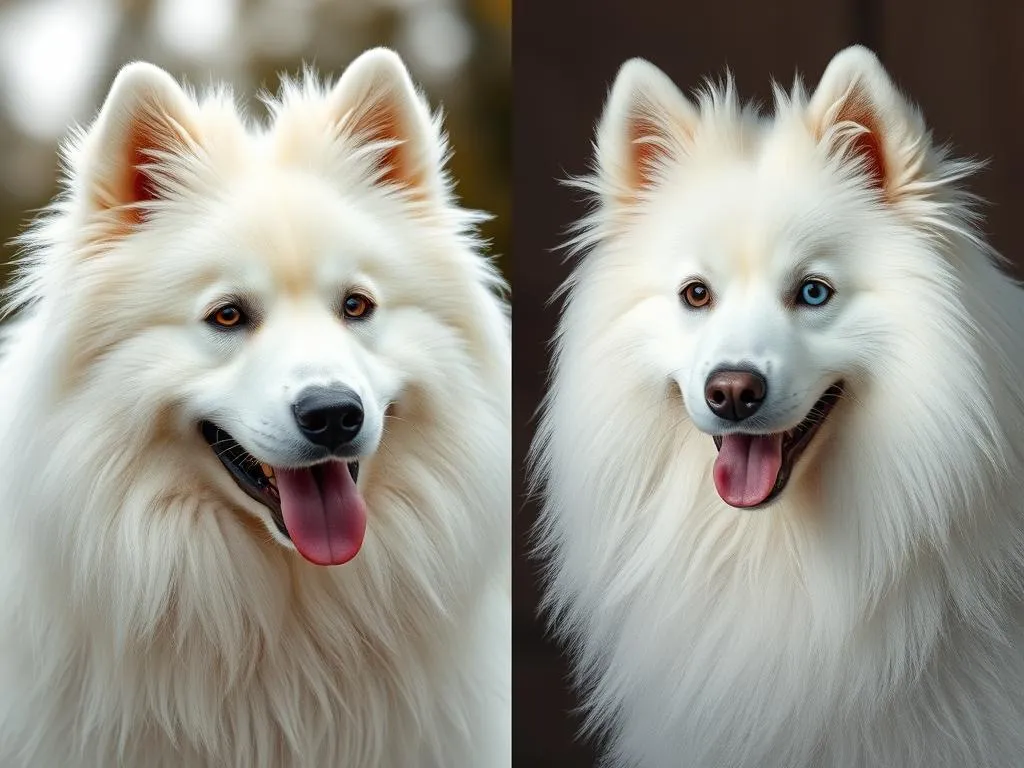
Introduction
The Samoyed is a captivating breed known for its stunning appearance and friendly disposition. Originating from Siberia, these dogs were initially bred by the Samoyede people for herding reindeer and pulling sleds. Their fluffy white coats, gentle eyes, and unmistakable “Sammy smile” make them one of the most beloved breeds around the world.
This article aims to compare male Samoyeds vs female Samoyeds, a topic of interest for potential owners looking to welcome a Samoyed into their home. Understanding the differences and similarities between the two genders can significantly impact your choice, ensuring a better fit for your lifestyle and preferences. We will cover various aspects, including physical characteristics, temperament, health considerations, lifestyle needs, and the cost of ownership.
Section 1: Physical Characteristics
Size and Weight
When considering a male Samoyed vs female Samoyed, one of the most noticeable differences is their size.
- Male Samoyeds typically stand between 21 to 23.5 inches at the shoulder and weigh between 45 to 65 pounds.
- Female Samoyeds, on the other hand, are slightly smaller, measuring around 19 to 21 inches and weighing between 35 to 50 pounds.
The size differences can affect your lifestyle and care routines. Larger males may require more space and resources, while females might fit better in smaller homes. However, both genders thrive in loving environments where they receive adequate attention and exercise.
Coat and Grooming
The coat of a Samoyed is one of its defining features. This breed has a double coat— a thick, fluffy outer layer and a dense undercoat that provides insulation against cold weather.
While both male and female Samoyeds have the same coat type, there may be slight differences in coat length and texture. Males often have a more robust and thicker coat, while females may have a slightly softer and silkier coat.
Grooming is essential for both genders, with regular brushing required to manage shedding and maintain coat health. Expect to spend more time grooming during shedding seasons when their undercoat is released, which can be twice a year.
Color Variations
The Samoyed breed is predominantly known for its beautiful white coat, but there are variations in shades, including cream and biscuit. Generally, there are no significant differences in color between male and female Samoyeds, as breed standards favor the same color palette for both genders. However, individual dogs may display subtle variations that can enhance their uniqueness.
Section 2: Temperament and Behavior
General Temperament
Samoyeds are known for their friendly and playful nature, making them excellent family pets. They are generally affectionate and good with children. However, there can be temperament differences between male and female Samoyeds.
Males may exhibit more dominant behaviors and can be more protective of their families. They might also display a slightly higher level of independence. Females, conversely, tend to be more nurturing and are often more attuned to their owner’s emotions, making them excellent companions.
Energy Levels and Playfulness
Both genders are highly energetic and require regular exercise. However, a comparative analysis of male Samoyed vs female Samoyed shows that males may have slightly higher energy levels. They often engage in more vigorous play and enjoy roughhousing, while females may prefer more structured playtime.
Regardless of gender, both male and female Samoyeds need daily activities such as walks, play sessions, and mental stimulation to keep them happy and healthy.
Trainability and Intelligence
Samoyeds are intelligent dogs that respond well to training. Both males and females are capable of learning commands and tricks, but there may be variations in trainability.
Males may be slightly more stubborn and require consistent training methods, whereas females often show higher levels of eagerness to please, making them easier to train. Regardless of gender, positive reinforcement techniques work best and should be employed to ensure a well-adjusted dog.
Section 3: Health Considerations
Common Health Issues
Like any breed, Samoyeds are prone to specific health issues. Common health problems include hip dysplasia, eye conditions (such as cataracts), and skin disorders.
Gender-specific health concerns also arise. Males may be more susceptible to certain reproductive issues, while females may face challenges related to their heat cycles and potential complications during pregnancy. Regular veterinary check-ups and a good diet can help mitigate these risks.
Lifespan
The average lifespan of both male and female Samoyeds ranges from 12 to 14 years. However, some studies suggest that females may live slightly longer than males, primarily due to the reduced risk of certain health issues. Factors influencing lifespan include genetics, diet, exercise, and overall health management.
Section 4: Lifestyle and Care
Exercise Requirements
Both male and female Samoyeds require significant daily exercise to maintain their health and happiness. A combination of physical activity and mental stimulation is crucial.
- Male Samoyeds may need more active play sessions and vigorous exercise, such as running or hiking.
- Female Samoyeds can also enjoy these activities but may be satisfied with a mix of structured play and leisurely walks.
Regardless of gender, ensure that your Samoyed receives at least 1 to 2 hours of exercise daily.
Living Environment
Samoyeds are adaptable dogs but thrive best in environments where they have space to roam. Males, being larger, may require more room to feel comfortable.
Both genders do well in homes with fenced yards, but they can also adapt to apartment living if given sufficient exercise. Socialization is key; both males and females should be introduced to various environments and people from a young age to develop their social skills.
Family Compatibility
When it comes to family dynamics, both male and female Samoyeds are generally good with children. However, males may exhibit more protective behaviors, making them suitable for families looking for a watchdog.
Females often display nurturing tendencies, making them great companions for children. Ultimately, the individual dog’s personality will play a significant role in compatibility, so meeting potential pets before making a decision is essential.
Section 5: Cost of Ownership
Initial Purchase Price
The initial cost of a Samoyed puppy can vary based on several factors, including gender. In general, male Samoyeds may be priced slightly higher due to their larger size and breeding potential. On average, you can expect to pay between $3,000 and $5,000 for a purebred puppy, with prices influenced by breeder reputation and lineage.
Ongoing Costs
Ongoing costs for both male and female Samoyeds include grooming, veterinary care, and food. Grooming expenses can be similar for both genders, although males may require slightly more due to their thicker coats.
Veterinary costs can vary based on health needs, and insurance premiums may differ slightly between genders, with males sometimes costing more due to potential reproductive health issues. Food quality is also essential, with high-quality diets being necessary for both genders to maintain their health.
Section 6: Personal Experiences and Testimonials
Owner Testimonials
Owners of male Samoyeds often describe their dogs as playful and boisterous, enjoying outdoor adventures and engaging in rough play. They appreciate the loyal nature of their males, who can be protective and affectionate.
On the other hand, owners of female Samoyeds frequently mention their dogs’ nurturing qualities. They find females to be more intuitive and sensitive, often forming strong bonds with family members and displaying a calm demeanor.
Expert Opinions
Veterinarians and breeders often highlight the importance of understanding the unique traits of male and female Samoyeds. They recommend considering your lifestyle, the energy levels of the dog, and whether you prefer a more playful or nurturing companion when deciding between the two genders.
Experts also stress the importance of responsible ownership, emphasizing that each dog is an individual. Regardless of gender, a Samoyed’s temperament, health, and behavior will ultimately depend on training, socialization, and the environment provided by their owner.
Conclusion
In summary, the comparison of male Samoyeds vs female Samoyeds reveals both differences and similarities that potential owners should consider. Males are typically larger, may exhibit more dominant behaviors, and often require more vigorous exercise. Females tend to be smaller, more nurturing, and may be easier to train.
Choosing the right gender depends on your lifestyle, living situation, and personal preferences. Regardless of your choice, both male and female Samoyeds make loving and loyal companions. Responsible ownership and an understanding of the breed’s specific needs will ensure a happy and fulfilling relationship with your new furry friend.









